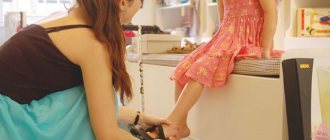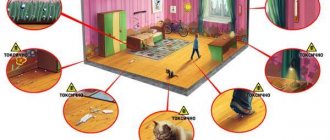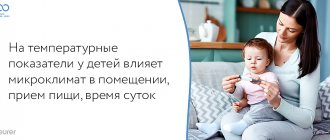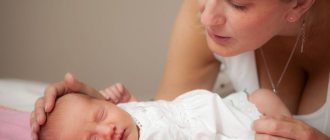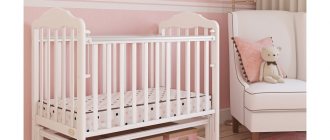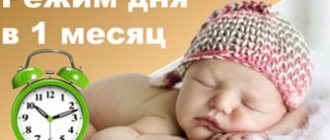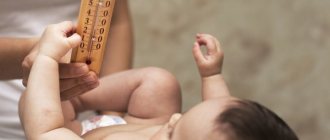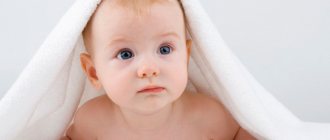With the birth of a child, many mothers think about how to maintain an optimal microclimate in their home. After all, this is very important for the health and development of the baby. If the air is too dry, crusts form in babies' noses, making it difficult to breathe. And this can cause snoring and restless sleep.
What humidity should be in a nursery?
Skin rashes, periodic coughing, sniffling - all these signs may not be cold symptoms at all, but a consequence of high or low humidity in the room. When exhaling, the air inhaled by the baby becomes 100% moist. If the humidity in the room is below 50%, then the child’s body will release moisture, and this leads to fluid loss. If a child consumes a small amount of liquid, dehydration may result.
In autumn and spring, the air humidity in the apartment is mostly normal. And in summer and winter it needs to be increased a little, because at these times of the year the air is drier. The following will help normalize the indicators:
- wet cleaning once a day;
- installing containers filled with liquid near heating devices and near the place where the child is most often located;
- ultrasonic or steam humidifier;
By controlling the temperature and humidity in the room, you can reduce the incidence of acute respiratory viral infections. The correct microclimate has a positive effect on the growth, development and well-being of the baby. However, before humidifying the air, it is necessary to measure the humidity, since high levels are also not desirable.
The children's body is structured a little differently; in children, all processes in the body go much faster than in adults. Thermoregulation in children is carried out through the skin and respiratory organs, and it is not perfect. The recommended room temperature for children is 18-20 degrees Celsius. During the day, while you are awake, it can reach 21-22 degrees, but during sleep it is better to lower it to 18 degrees. Do not forget about ventilation, it is carried out 2-3 times a day. It is better to ventilate the apartment during walks, as well as before going to bed. The correct microclimate improves:
- appetite;
- mood;
- general well-being;
On a note!
Newborns have poorly developed sweat glands.
The recommended air humidity in an apartment or house for a child should be from 50 to 70%. This can be determined using a device called a hygrometer. It is sold in hardware stores. You can also use Magik Air - this is a smart microclimate system, you can even control it with the help of gadgets.
Why do you need a humidifier in a nursery?
A good humidifier can maintain a comfortable microclimate and clean the room from dust and bacteria. Children have weaker immunity compared to adults. During active games, the smallest particles of dust along with bacteria rise to the top.
The drier the air, the more dust is scattered in it. Children's short stature and their habit of playing on the floor increase the risk of inhaling polluted air. Using a humidifier reduces dust levels and reduces the incidence of viral and respiratory diseases.
How to humidify the air
Many ways have been invented for this. The most effective is to buy a humidifier, they come in several types, one of the best is ultrasonic, it is almost silent and gets the job done faster. However, it is not always possible to buy it, and then folk methods will come to the rescue:
- A wet sheet - it is hung on the radiator, and when it dries, it is replaced with another one.
- A container of water is placed near the battery.
- A plastic bottle with a hole cut out in the middle is hung on the battery and filled with water. Afterwards, take several pieces of fabric, gauze or bandage, lower one end into water, and tie the other to the battery.
- Vessels with water can also be placed on furniture, the effect will be less noticeable, but it will be there.
How to reduce air humidity
High humidity also adversely affects the development and health of the baby. After all, due to dampness, the temperature in the apartment decreases. Also, in a damp room, an unpleasant odor appears and a fungal coating may form on the walls or furniture. And through the respiratory system, toxic substances enter the lungs. The child usually begins to get colds more often. Therefore, high humidity also needs to be dealt with.
To normalize indicators, you first need to identify the reason for their increase. Often the source of moisture is an external wall. You can conduct a small experiment: a piece of glass is applied to the wall, and if condensation has formed between it and the wall, then the source has been found. In this case, the outer wall must be insulated using vapor-permeable materials. It is also necessary to better heat an apartment or house, and for this you may need additional heat sources (heater or convector). If the humidity rises periodically, it is advisable to follow the following recommendations:
- ventilate the room three times a day;
- insulate window openings;
- eliminate draft sources (floor, walls)
- install moisture absorbers or dehumidifiers;
A child and an air conditioner: doctors’ opinion and installation rules
A children's room is a room in our apartments in which the choice of household appliances must be approached with special care. Devices for maintaining a microclimate, including air conditioning, are no exception. The health and development of our children depends on how the split system is selected and positioned.
Content:
- Is it worth installing an air conditioner in the nursery?
- Air conditioning and newborn
- Requirements for equipment in a room with children
- Air conditioner temperature for baby
- Selecting the power of climate control equipment
- Comfortable air conditioner temperature for a child
- Selecting the power of climate control equipment
- Selecting a device type
- Rules for installing an air conditioner in a children's room
- Recommendations for using an air conditioner in a room with children
- conclusions
IS IT WORTH INSTALLING AN AIR CONDITIONER IN A CHILDREN'S ROOM?
The nursery, like any other living space in our home, requires certain temperature and humidity conditions that are necessary for the optimal functioning of the human body, including at an early age. However, unlike an adult, a child’s body is more susceptible to the effects of colds, so the choice of model and location of the cooler in a given room must be approached more carefully.
Many parents, fearing for the health of their children, want to know whether the air conditioner in the nursery is dangerous, and if it is not worth installing, then why. Parents' concerns stem from the popular belief about drafts created by climate control devices. In everyday life you can often hear that a child was blown out by an air conditioner, his temperature rose and he got sick.
Yes, such opinions exist, and the problem exists, or rather did occur. Progress is moving forward by leaps and bounds and climate control equipment is developing in step with it.
However, modern split systems are qualitatively different from those ten to twenty years old. The technology is completely different, and when installed correctly the equipment is safer.
Many doctors believe that using an air conditioner in a room where a child is located is not only possible, but also necessary.
An example of such doctors is Evgeniy Komarovsky, Candidate of Medical Sciences, author of many scientific books .
In his opinion, it is necessary to cool the room where the child is located. The main thing to take precautions is to avoid direct air flow onto the cribs and control the humidity in the room, since air conditioning noticeably dries out the air.
In addition, the air conditioner is capable of:
- It is enough to thoroughly clean the air from dust and allergens.
- During the cold period, it is effective to heat the air in the room. This is especially true during periods of temporary heating shutdown.
“You shouldn’t be afraid of an air conditioner in a nursery if it is selected and installed correctly”
AIR CONDITIONER AND NEWBORN
Is it possible to turn on the air conditioner when you are breastfeeding? And if so, what should a conditioner for newborns be like?
The answer to this question is also given by Dr. Komarovsky. Can! Moreover, the younger the baby, the easier it will be for him to adapt to life in air-conditioned air.
Naturally, safety measures are required when placing the device, its quality selection and control of temperature and humidity conditions.
REQUIREMENTS FOR EQUIPMENT IN A ROOM WITH CHILDREN
An air cooler in a room with children must have certain qualities:
- The air conditioner should only be of the inverter type. Sudden changes in temperature in a room with a child are not acceptable.
- A child's sleep is sensitive, so the equipment model must meet the minimum noise characteristics. It is necessary to select a device no louder than 23 dB.
- During operation, the split system significantly dehumidifies the air inside the room. Therefore, it is necessary to either select models with air humidification, or periodically ventilate the room, or purchase a household humidifier.
- The equipment must include modern antibacterial filters.
- The system must be equipped with a “night mode” function. With every hour in this mode, the device gradually raises the temperature in the room by 0.5 - 1 degree.
- It is advisable to use equipment with a smart eye system. Cooled air should not reach exposed areas of the child's body.
AIR CONDITIONER TEMPERATURE FOR CHILD
For a child, as for an adult, the optimal temperature in the room is considered to be from 22 to 24 degrees. Constantly exceeding this regime leads to lethargy, chronic fatigue, loss of performance, and decreased brain activity, including in schoolchildren. At the same time, the body of children, unlike adults, is more susceptible to the influence of colds. Therefore, it is not recommended to lower the temperature in the children's room below 22 degrees.
“The optimal temperature in the nursery is 22 – 24 degrees. Raising the indoor temperature by 1.5 degrees reduces the efficiency of the human brain by 40%."
SELECTION OF CLIMATE EQUIPMENT POWER
The choice of cooling or heating power of a split system for a children's room is similar to the selection for any other room.
At the household level (without the help of specialists), it is recommended to use models with cooling power:
- 2.0 - 2.3 kW for rooms up to 20 m²
- 2.5 – 2.7 kW for rooms from 21 to 27 m²
- 2.8 – 3.7 kW for rooms from 28 to 37 m²
SELECTING A DEVICE TYPE
Due to the specific nature of children's rooms, we do not recommend installing equipment with a powerful straight air flow. Column, cassette and ceiling split systems should be immediately excluded from the types.
The most common type of equipment for children is the wall-mounted type. However, the optimal solution from the point of view of air flow distribution, cooling “softness” and noise characteristics is a low-pressure ducted air conditioner. The indoor module is located behind the ceiling in a utility room (bathroom or dressing room), only ventilation grilles are installed in the nursery, the air from which spreads along the ceiling, uniformly and smoothly cooling or heating the room.
RULES FOR INSTALLING AN AIR CONDITIONER IN A CHILDREN'S ROOM
- The internal module of the cooling system must be positioned so that the air flow does not fall on open areas of the child’s body for a long time. Cooled air should not be directed towards the child's bed, play area or study area.
- The child should not be physically able to reach the system with his limbs - the air conditioner has many rotating parts.
- The control panel should be located out of reach of a child. A sharp decrease in room temperature can lead to a cold.
RECOMMENDATIONS FOR USING THE AIR CONDITIONER IN A ROOM WITH CHILDREN
- Make sure that the air flow does not fall on the child for a long time.
- Do not lower the temperature in the nursery below 22 degrees.
- During breaks in equipment operation, periodically ventilate the premises, and during operation of the split system, it is advisable to use an air humidifier.
- Clean and wash the coarse filters on the indoor unit yourself as often as possible.
- When your child sleeps, turn on the night mode of the air conditioner.
- Periodically carry out equipment maintenance with complete disinfection of the indoor unit by involving specialized specialists.
RESULT
To the banal judgment of parents that it is better for the child to be hot than cold, modern climate systems and doctors give their answer - let it be comfortable!
Author of the article: chief engineer Semyon Semenych.
How to Maintain Humidity Levels for a Newborn
It is believed that the temperature in a baby’s room should vary from 18 to 20 degrees. It should be remembered that each child is individual, and the temperature in the room should be adjusted depending on the child’s behavior and well-being. Many mothers and grandmothers, having arrived from the maternity hospital, wrap up their babies, while turning on all kinds of heating means. This is not correct, because they dry the air, and as a result, the baby may experience:
- increased body temperature (a common occurrence with overheating);
- bloating;
- difficulty breathing due to dry mucous membranes;
On a note!
Premature babies need warmth, 18-20 degrees for them is a low temperature.
To monitor the thermometer readings, you need to hang a thermometer next to the crib. In winter, to reduce the indicators, the room is ventilated; it is better to do this while walking. In summer, the temperature in the room can be adjusted using an air conditioner, but it is better to do this also without a child in the room. In hot weather, you need to water and bathe your baby more often, this will help prevent dehydration.
What should be the temperature and humidity in a newborn’s room?
The baby spends almost entirely the first weeks of his life in his room, so it is very important to create a comfortable atmosphere in it. In addition, the newborn spends most of the day sleeping, as he is just beginning to adapt to new conditions. Thermoregulation, like most body systems, is not yet fully formed. Therefore, parents must ensure optimal temperature and humidity in the nursery.
To keep the baby from freezing and overheating, pediatricians recommend keeping the room at +22 degrees and humidity 40-60%. And some experts believe that this figure can be reduced to 18-19 C0. This is the temperature in the room for a newborn that is most suitable for the baby to feel great, sleep peacefully and eat with appetite.
Normal indicators for a baby in winter
During the cold season, it is quite difficult to maintain the optimal temperature in the room for a newborn baby, due to the unstable operation of the central heating. Sometimes the room is too hot, and sometimes, on the contrary, it is cool. In addition, heating devices dry the air, which leads to a significant decrease in humidity levels. You can achieve the most comfortable temperature for winter + 23 degrees and 60% humidity in different ways.
You can reduce the temperature in the bedroom by covering the radiators with a special plastic or wooden box. Ventilating the room every four hours will not only reduce the temperature, but also provide the necessary humidity. Of course, while airing the newborn, you need to take it out of the room. You can increase the temperature using any modern heaters, without forgetting about humidifying the air.
Intense air circulation in the crib is also very important for good health and good sleep. Therefore, in winter, it is better to remove canopies and curtains so that the baby receives as much oxygen as possible.
Comfortable temperature for babies in summer
In summer, the temperature and humidity of the children's room almost entirely depends on weather conditions. Therefore, creating a favorable microclimate in it is even more difficult than during the cold period. Ventilation and artificial humidification of the air in extreme heat will not provide the optimal 22 degrees and fifty percent humidity.
The only solution to this problem is to install an air conditioner. If possible, it is better to place it in the next room. It is recommended to turn on this miracle of technology when the newborn is not indoors, for example, during a walk. Of course, it is necessary to promptly clean the filters of the device, in which pathogenic microorganisms can accumulate.
In order for the baby to feel good on hot days, it is necessary to ensure normal heat exchange in the body. To do this, pediatricians advise following simple rules in caring for your child. First of all, wear only light clothing made from cotton fabrics. Give him a little more water than on normal days. Carry out air and water procedures more often. Protect the child from exposure to sunlight. Do daily wet cleaning of the children's room, because in summer, when airing, much more dust gets into the room.
What to do in the off-season and with frequent temperature changes
In spring and autumn, maintaining an optimal level of humidity in the children's room is quite simple, since the street air is well saturated with moisture. A few ventilations are enough to provide a comfortable atmosphere in the room.
And there are no special problems with the temperature regime. If necessary, the child’s bedroom can be heated using modern appliances. And if it’s too hot, lower the temperature by ventilating. The main thing is to monitor the thermometer and hygrometer readings throughout the day.
In the off-season, pay special attention to your newborn's clothing. If the nursery is cool, it will take some time to restore the optimal temperature. To keep your baby from getting cold and catching a cold, of course, you need to wear a warm blouse, pants, socks and a hat. Once the required parameters are reached, it is recommended to remove excess clothing to prevent overheating of the body.
Komarovsky's opinion
What this famous doctor thinks is of interest to many parents, because his advice is not only reasonable, but also useful. Komarovsky associates the increase in morbidity rates in the cold season with dry air. After all, heating devices often actually dry it out. The nose contains villi that trap viruses and pathogenic microorganisms and prevent further penetration. And since the air is too dry, the nasal mucosa dries out, and the villi in this case are not able to fulfill their purpose. Then viruses and infections easily enter the body, and as a result the child gets sick.
Regarding the norm of air humidity in an apartment for a child, Komarovsky adheres to the opinion of the majority of doctors. This is especially important for a sick child, because it is much easier to transform a dry cough into a productive one in high humidity. If it is not possible to raise it, it is recommended to give the child something to drink more often and rinse the nose with saline solution.
What to do if the room is damp?
Excessive humidity in a baby's room is just as unfavorable as excessive dryness .
Too humidified air significantly lowers the room temperature. Hypothermia of a child in a damp room threatens frequent colds , which begin with rhinitis. If measures are not taken to normalize the humidity in the room, a chronic runny nose can develop into sinusitis.
Constant dampness causes the development of mold on the walls and ceiling, fungal microorganisms on furniture.
Toxic spores with the air enter the lungs and esophagus of a fragile child’s body. Hence the occurrence of allergic reactions, general intoxication, mycoses of internal organs. Dampness and excess air humidity must be combated by all available means.
Reviews
Alevtina 23 years old
Let me start with the fact that I worked almost until I gave birth and there was simply no free time to study literature about children. After giving birth, like all inexperienced mothers, I tried to wrap my daughter up tightly so that she wouldn’t freeze, and the heating was turned on all the way. But after a week I felt somehow uneasy, my health worsened, and the baby began to sleep poorly. I called the pediatrician, decided that I had not saved my daughter, and she got sick. Imagine my surprise when I was scolded for the heat, because, in my opinion, the child should be warm. The doctor also recommended measuring the humidity and if it is low, buy a humidifier. I lowered the temperature, although at first I dressed warmly. The humidity turned out to be 30%, so we bought a humidifier. And after a week, the baby became much calmer, her breathing returned to normal, and I began to feel better.
Marina
We finally bought an apartment, and in the fall the whole family began to get very sick. The apartment was terribly damp; it turned out to be the floor and the corner wall. We spent the whole winter with a runny nose and cough. With the arrival of summer, the dampness seemed to have disappeared, we insulated the corner, the floors, it turned out that when installing the windows we had not sealed the cracks, everything was fixed. In the fall, dampness did not appear, and the readings on the hygrometer did not exceed 50%, we also began to get sick much less.
The microclimate in the apartment greatly affects the health and well-being of children. Both increased and decreased temperatures and humidity have a negative impact and must be regulated. It is especially important to control humidity if there are newborn children in the house. After all, they are just adapting to this world and all organs and systems are still working imperfectly.
